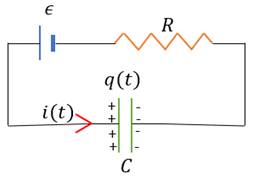A capacitance C, a resistance R and an emf ϵ are connected in series at t = 0. What is the maximum value of
(a) the potential difference across the resistor,
(b) the current in the circuit,
(c) the potential difference across the capacitor,
(d) the energy stored in the capacitor,
(e) the power delivered by the battery and
(f) the power converted into heat.
Energy stored in a capacitor:
The energy stored in a capacitor with capacitance C , charge is given by:
![]()
where V is the potential difference across the capacitor.
Power supplied by the battery:
If a battery of emf ϵ gives a current I, then the power supplied by the battery is given by:
![]()
Kirchhoff’s loop rule:
The sum of potential differences around a closed loop is zero.
Potential Difference (V) across a resistor of resistance R when current I passes through it is given by Ohm’s law:
![]()

(a)
By Kirchhoff’s loop rule, ![]()
![]()
As ϵ is constant, ![]()
At t = 0, there is no charge on the capacitor. Hence ![]() . So, Vr is maximum at t = 0.
. So, Vr is maximum at t = 0.
![]()
(b) Initially, current flows through the circuit treating capacitor as short-circuit. But as charge accumulates on the capacitor the current reduces with time. It is maximum at t =0.
Using Kirchhoff’s loop rule,
![]()
![]()
I is max at t = 0 and ![]()
![]()
![]()
(c)
Using Kirchhoff’s loop rule,
![]()
![]()
As R and ϵ are constant
![]()
Current is minimum at equilibrium when capacitor acts as an open switch and current is zero. Hence, ![]()
![]()
(d)
The energy stored by the capacitor is given by:
![]()
As C is constant,
![]()
We know from (c) that the maximum potential difference across the capacitor is ϵ. Hence,
![]()
(e)
Power delivered by the battery is given by:
![]()
As ϵ is a constant,
![]()
Using the result from (b), we get
![]()
![]()
(f)
The resistor converts energy into heat:
![]()
As R is constant,
![]()
Now, using the result from (b),
![]()